冀教版五年级英语第五册课至课教案
冀教版小学五年级英语下册《Lesson 05 Who Is Hungry》教案
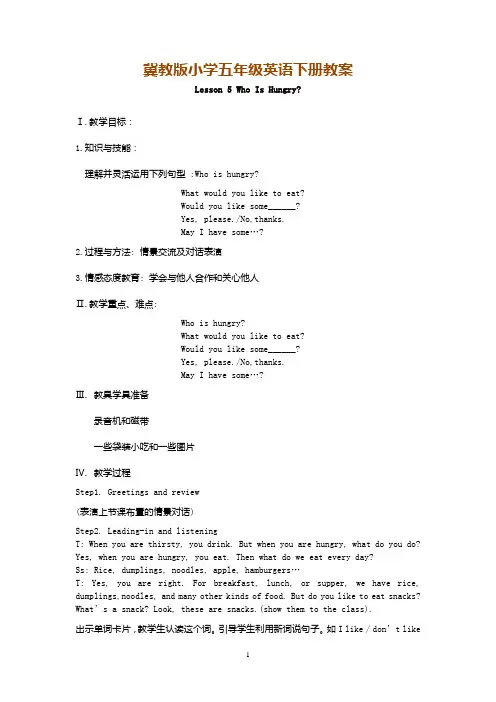
冀教版小学五年级英语下册教案Lesson 5 Who Is Hungry?Ⅰ.教学目标:1.知识与技能:理解并灵活运用下列句型 :Who is hungry?What would you like to eat?Would you like some______?Yes, please./No,thanks.May I have some…?2.过程与方法: 情景交流及对话表演3.情感态度教育: 学会与他人合作和关心他人Ⅱ.教学重点、难点:Who is hungry?What would you like to eat?Would you like some______?Yes, please./No,thanks.May I have some…?Ⅲ. 教具学具准备录音机和磁带一些袋装小吃和一些图片Ⅳ. 教学过程Step1. Greetings and review(表演上节课布置的情景对话)Step2. Leading-in and listeningT: When you are thirsty, you drink. But when you are hungry, what do you do? Yes, when you are hungry, you eat. Then what do we eat every day?Ss: Rice, dumplings, noodles, apple, hamburgers…T: Yes, you are right. For breakfast, lunch, or supper, we have rice, dumplings,noodles, and many other kinds of food. But do you like to eat snacks? What’s a snack? Look, these are snacks.(show them to the class).出示单词卡片,教学生认读这个词。
冀教版五年级下册英语Lesson 5 (3)教案与反思
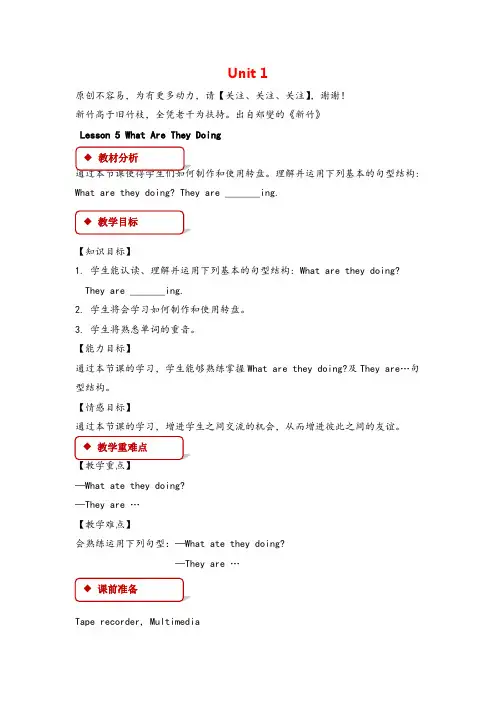
Unit 1原创不容易,为有更多动力,请【关注、关注、关注】,谢谢!新竹高于旧竹枝,全凭老干为扶持。
出自郑燮的《新竹》Lesson 5 What Are They Doing: What are they doing? They are _______ing.【知识目标】1. 学生能认读、理解并运用下列基本的句型结构: What are they doing?They are _______ing.2. 学生将会学习如何制作和使用转盘。
3. 学生将熟悉单词的重音。
【能力目标】通过本节课的学习,学生能够熟练掌握What are they doing?及They are …句型结构。
【情感目标】通过本节课的学习,增进学生之间交流的机会,从而增进彼此之间的友谊。
—What ate they doing?—They are …【教学难点】会熟练运用下列句型:—What ate they doing?—They are …Tape recorder, Multimedia◆教学过程Step 1. Let’s review1. greetings(1) say hello to the students when they arrive in the classroom. Then take some time to review the content of the last class. Let the students remember what they did in the class.(2) let a brave man stand up and say what has happened to this unit so fa r. Teachers can use the following questions to help students recall: Where are they going on the train?What does Mrs. Li tell Danny?What o they see on the train?What do they do on the train?What is the baby doing?Are they hungry/thirsty on the train?2. text introductionTeacher: Today, we are going to make a spinner and play a very.Step 2. Presentation1. People on the train(1)let the students turn to tenth pages and look at the first part. Takea few minutes to watch the picture.Pointing to each picture, ask: What are they doing? Students can answer the teacher's quesion in Chinese.Teacher: Look at the first picture. What s the woman doing?The whole class: She is reading the newspaper.Teacher: What are the people doing in the second picture?The whoe class: Tey are playing cards.Teacher: Look at the third picture. What is Danny doing?Th e whole class: He is playing with the baby.(2) play the tape when teachers feel students undersand the content of the picture, and let the students read books to read. Play it again, let the students read aloud.(3) finally, do not play the recording, but let the three students stand up and read the text in their roles. They play Jenny, Li Ming and Danny respectively.2. demoLet the four men come to the front of the brave. Tell them what they need to demonstrate: two students pretend to cry;One student pretended to read the newspaper; a student pretended to play poker; a student pretended to hold a baby. When the students do these actions, the students in the class are encouraged to answer the questions: What is he/she doing?Now, let the four brave men do the same thing at the same time and ask other students: What are they doing?Wait for the student to answer the question correctly.3. practiceListen and guessWrite the following sentences on the blackboard.The baby is crying.The woman is reading the newspaper.The people behind Jenny are playing cards.Danny is playing with the baby.Let a brave man stand in front of the classroom and face the whole class. Now, the teacher points to every sentence. Let the students do the corresponding action, and the self - volunteered students say the right sentence.Step 3.PracticeLet's do it!Make, spin and write.This is a very good hands-on game. Gather all the students, let them round a circle, the teacher is in the middle. Show them eleventh pages of a turntable. Explain to the student how to use a turntable to turn the turntable by the teacher. When it stops turning, the teacher writes the content pointing to himself in the whole white place.The teacher makes a turntable and the student pays attention to it. Step:Outer circle big circle:1. draw a big circle on the picture paper and cut it down.2. divide the big circle into six equal parts and draw the dividing line with a pencil.3. write the words and draw the pictures at the top of the six parts.4. to color pictures.Inner circle small circle:1. draw a medium round circle on the picture paper, with a small circle in it, and then cut it down. (the two circles operate as a whole.)2. draw a segmentation line, divide the two circles into six equal parts, and match the big circle.3. in these six parts, write six different pronouns and correct "be" verb forms, namely: Lam, We are, They are, She is, You are, He is4. put the inner circle in the big circle of the outer ring.5. a pin in the center of the turntable.Finally, write the correct sentences in the blanks below the turntable in the textbook.When the students understand how to make a turntable, let the students set up two people and give them time to make a turntable.Answer: They are playing ping-pong. She is swimming. You are singing. He isAlternative activitiesWhen each group has finished the turntable, you can use a turntable to play the game.The students sat face to face. A student rotates the turntable, and when the turntable stops turning, a triangle will face the student. Second students asked: What are you doing?The student should answer the contents of his / her triangle. For example: Student a: What are you doing?Student B: (read the content in the triangle) We are eating.Now when the teacher rotates the turntable, the turntable should be revolving around the pin for a period of time and stop. When the turntable is stopped, the triangle that points to the teacher is what the student wants to write on the line under the turntable.Listen and repeat.Let the students look at 11 pages and third parts. Play the recording, the students sit quietly, listen to the reader read eight words. Listen again, please listen to this.Now, write the words on the blackboard. The teacher while writing and reading, and let the students follow. The teacher should make sure that the accent of each word is stressed in a loud and exaggerated tone. Finally, point to the word and let the brave man stand up and read the word.Step 4. ConsolidationLet the students list what people do on the train from first to fifth. "Handbook of activities"Help students find the exercises they need to do. Turn over that page and lift it up.Step 5. SummaryNow the time to describe is doing something.I am drawing.We are eating.They are playing ping-pong.Step 6. HomeworkThe part of the partner performs the dialogue in the text.【素材积累】不怕你不懂不会,旧怕你不学不干。
冀教版五年级英语第五册课至课教案
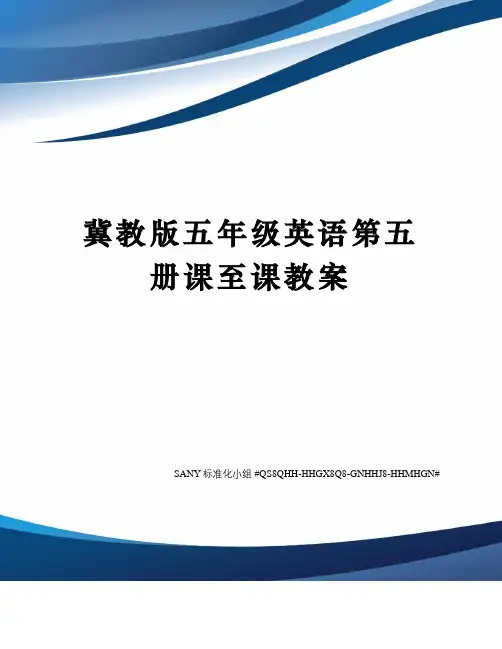
( )2、A、comes B、come C、coming
( )3、A、am B、is C、are
( )4、A、to B、on C、for
( )5、A、on B、in C、at
( )6、A、likes B、liked C、like
( )7、A、too B、to C、two
____________________________________________
3、Come and leave .Are they the same
________________________________________
4、How many buses are there
_______________________________________
_____6:30 ______Summer _____Sunday
______the evening _____March
_______Monday morning
教学反思
课题
Lesson 22: Leaving and Arriving
课型
新授课
课时
2-2
教
学
目
标
知识与技能:掌握反义词leave –arrive,go-come;能够制作简单的旅行小计划。
过程与方法:通过小组学习,对手竞赛,巩固学过的知识。
情感、态度和价值观:培养学生良好的复习学习习惯。
重点
难点
重点: 三单元的单词,词组,句子
难点:培养学生灵活运用的能力。
学法
指导
学生活动
教具
学具
单词卡
冀教版《学英语》第五册集体备课教案
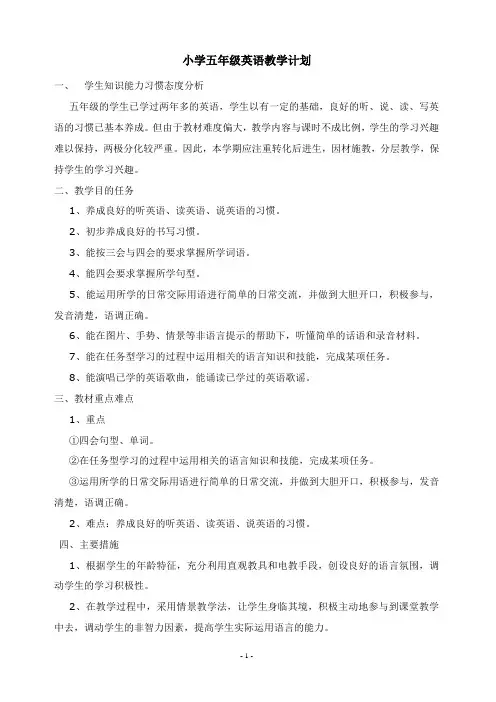
小学五年级英语教学计划一、学生知识能力习惯态度分析五年级的学生已学过两年多的英语,学生以有一定的基础,良好的听、说、读、写英语的习惯已基本养成。
但由于教材难度偏大,教学内容与课时不成比例,学生的学习兴趣难以保持,两极分化较严重。
因此,本学期应注重转化后进生,因材施教,分层教学,保持学生的学习兴趣。
二、教学目的任务1、养成良好的听英语、读英语、说英语的习惯。
2、初步养成良好的书写习惯。
3、能按三会与四会的要求掌握所学词语。
4、能四会要求掌握所学句型。
5、能运用所学的日常交际用语进行简单的日常交流,并做到大胆开口,积极参与,发音清楚,语调正确。
6、能在图片、手势、情景等非语言提示的帮助下,听懂简单的话语和录音材料。
7、能在任务型学习的过程中运用相关的语言知识和技能,完成某项任务。
8、能演唱已学的英语歌曲,能诵读已学过的英语歌谣。
三、教材重点难点1、重点①四会句型、单词。
②在任务型学习的过程中运用相关的语言知识和技能,完成某项任务。
③运用所学的日常交际用语进行简单的日常交流,并做到大胆开口,积极参与,发音清楚,语调正确。
2、难点:养成良好的听英语、读英语、说英语的习惯。
四、主要措施1、根据学生的年龄特征,充分利用直观教具和电教手段,创设良好的语言氛围,调动学生的学习积极性。
2、在教学过程中,采用情景教学法,让学生身临其境,积极主动地参与到课堂教学中去,调动学生的非智力因素,提高学生实际运用语言的能力。
3、活用教材,根据学生会的实际情况,将每单元各个板块重现组排降低难度。
教学进度表周次日期教学内容页码备注第 1周8/27--8/29 Lesson1第 2周8/31--9/5 Lesson2,3第 3周9/7--9/12 Lesson4,5第 4周9/14-9/19 Lesson6,7,8第 5周9/21--9/26 Lesson9,10第6周9/28---10/3 Lesson11第 7周10/5--10/10 Lesson12,13第 8周10/12--10/17 Lesson14,15,16第 9周10/19--10/24 Lesson17,18第 10周 10/26---10/31第 11周11/2--11/7第 12周11/9--11/14 Lesson19,20第 13周11/16--11/21 Lesson21,22第 14周11/23--11/28 Lesson23,24,25第 15周11/30---12/5 Lesson26,27第 16周12/7--12/12 Lesson28,29第 17周12/14--12/19 Lesson30,31第 18周12/21--12/26第 19周12/28---1/2第 20周1/4--1/9Lesson 1: Fathers Mothers Brothers and Sisters教学目标:知识与技能:在本课中,孩子们掌握并能充分运用家庭成员的词语,例如 father mother son daughter grandfather grandmother brother and sister.能够准确的理解并练习 older younger ,并在原有基础上做“举一反三”练习。
冀教版《学英语》第五册集体备课教案

小学五年级英语教学计划一、学生知识能力习惯态度分析五年级的学生已学过两年多的英语,学生以有一定的基础,良好的听、说、读、写英语的习惯已基本养成。
但由于教材难度偏大,教学内容与课时不成比例,学生的学习兴趣难以保持,两极分化较严重。
因此,本学期应注重转化后进生,因材施教,分层教学,保持学生的学习兴趣。
二、教学目的任务1、养成良好的听英语、读英语、说英语的习惯。
2、初步养成良好的书写习惯。
3、能按三会与四会的要求掌握所学词语。
4、能四会要求掌握所学句型。
5、能运用所学的日常交际用语进行简单的日常交流,并做到大胆开口,积极参与,发音清楚,语调正确。
6、能在图片、手势、情景等非语言提示的帮助下,听懂简单的话语和录音材料。
7、能在任务型学习的过程中运用相关的语言知识和技能,完成某项任务。
8、能演唱已学的英语歌曲,能诵读已学过的英语歌谣。
三、教材重点难点1、重点①四会句型、单词。
②在任务型学习的过程中运用相关的语言知识和技能,完成某项任务。
③运用所学的日常交际用语进行简单的日常交流,并做到大胆开口,积极参与,发音清楚,语调正确。
2、难点:养成良好的听英语、读英语、说英语的习惯。
四、主要措施1、根据学生的年龄特征,充分利用直观教具和电教手段,创设良好的语言氛围,调动学生的学习积极性。
2、在教学过程中,采用情景教学法,让学生身临其境,积极主动地参与到课堂教学中去,调动学生的非智力因素,提高学生实际运用语言的能力。
3、活用教材,根据学生会的实际情况,将每单元各个板块重现组排降低难度。
教学进度表周次日期教学内容页码备注第 1周8/27--8/29 Lesson1第 2周8/31--9/5 Lesson2,3第 3周9/7--9/12 Lesson4,5第 4周9/14-9/19 Lesson6,7,8第 5周9/21--9/26 Lesson9,10第6周9/28---10/3 Lesson11第 7周10/5--10/10 Lesson12,13第 8周10/12--10/17 Lesson14,15,16第 9周10/19--10/24 Lesson17,18第 10周 10/26---10/31第 11周11/2--11/7第 12周11/9--11/14 Lesson19,20第 13周11/16--11/21 Lesson21,22第 14周11/23--11/28 Lesson23,24,25第 15周11/30---12/5 Lesson26,27第 16周12/7--12/12 Lesson28,29第 17周12/14--12/19 Lesson30,31第 18周12/21--12/26第 19周12/28---1/2第 20周1/4--1/9Lesson 1: Fathers Mothers Brothers and Sisters教学目标:知识与技能:在本课中,孩子们掌握并能充分运用家庭成员的词语,例如 father mother son daughter grandfather grandmother brother and sister.能够准确的理解并练习 older younger ,并在原有基础上做“举一反三”练习。
冀教版小学英语第五册Lesson教案
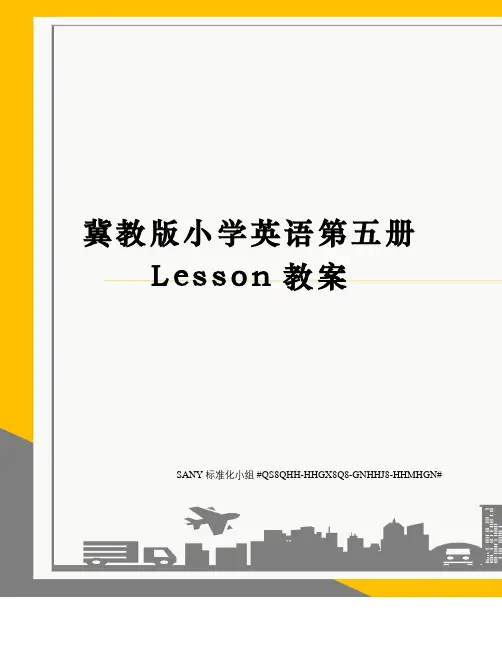
3.This apple is _____( big ) than that apple.
4.My mother is ______( young ) than my father .
5.My brother is _____( short课题
Lesson1 Fathers,Mothers,Brothers and Sisters
课时
1课时
教学目标
掌握家庭成员词语及形容词比较级的用法
教学重点
难点
形容词比较级的用法
教学准备
录音机 单词卡片
通案
个案
一、复习
唱“The Family in Our House”用以复习第1册所掌握的有关家庭成员的词汇
教师:(指着学生甲对学生乙说)You are his/her ___(家庭成员).How old are you
学生乙:I am ___ years old.
教师:(对学生甲)This is your ___(家庭成员).How old is he/she
学生甲:___ years old .
教师:(指着学生甲,对着全班同学)Is he/she older/younger
全班:Yes/No.
教师:Right!He/she is older/Sheis older/younger than his/her ___(家庭成员)
2.利用《活动手册》做听力练习
五、课堂小结
这节课你学会了什么
课堂检测
一用所给单词的适当形式填空:
1.I am ______ ( old ) than my sister.
冀教版五年级英语第五册课教案
看课件,听对话,跟读对话,想对话的大概意思。
引导学生两人一组,进行对话练习。
A、How far is it from ___to ___
B、About ___kilometres.
四、Practice.(练习)
与学生一起进行情景演示教师巡回指导。
五、Homework.
师与学生一起就come go 进行角色表演。
3、引导学生说句子
Iwant to go on a trip to Beijing! HereIgo .
(停下并指向一名学生)You come too!
4、看课件,学习对话
学生看课件,学习课文想一想对话的大概意思
组组进行、对话练习。
四、Practice.
1、全班分成两人一组,练习
出示卡片,朗读单词.
三、Study the new lesson.
1、导入新课,板书课题。
2、指导学生记忆单词。
hundred kilometers
学生看图片,跟读单词。
分小组读准单词。
朗读并记忆单词。
3、
学生看课件,想一想对话的大概意思。
教师讲解词组from --- to---
Fox example
二、Practice and review.
出示卡片,拼读单词.
trip kilometers invite , when
hundred
三、Study the new lesson.
1、导入新课,板书课题。
2、指导学生记忆单词
fast slow faster slower
take a bus / train/plane (看图片,跟读单词)
冀教小学英语五年级上册优质教案:Lesson 5 Having Fun Together(1)
Unit 1 My FamilyLesson 5 Having Fun Together教学目标:1.知识目标(1)学生能听懂、会说、认读并书写下列词汇:we, family, film, watch a film(2)学生能认读、理解并应用下列句型:We like to……2.能力目标通过游戏、表演等活动,培养学生语言运用能力,通过学习语言知识,培养学生对知识的迁移能力和发散思维能力。
3.情感目标让学生体会英语学习中的乐趣,敢于表达自己的情感。
教学重点:1.学生能听懂、会说、认读并书写下列词汇:we, family, film, watcha film2.学生能认读、理解并应用下列句型:We like to……教学准备:录音机、磁带教学课时:2课时教学过程:第一课时Step1:Warm-up做Whisper游戏以复习词汇:plant flowers, go for a walk, cook, go shopping, read a book, work on the computer等。
在全班猜出每个动作后,问全班同学Where is he/she?然后再问What is he/she doing?Step 2: Presentation1.问题讨论课文图片,引出并学习新词汇(we, family, film, watch afilm)What do they do?2.练习新词汇。
watch a film at the cinemawatch animals at the zooplant vegetables on the farmfly kites in the park大小声读,小组读,表演读3.播放课文录音,学生跟读。
4.师领读,请小老师领读,教师及时正音。
Step 3: Consolidation and Practice以小组为单位,互相介绍家庭成员的爱好。
第二课时Step1:Warm-up链式游戏:每个学生必须用到关于家庭成员喜好及其地点的短语T: My father likes to go for a walk.S1: My uncle likes to watch a film at the cinema.S2: …Step 2: Practice1. 画一画,说一说要求每个学生画一张家庭成员在一块玩的图画,要标出图片里的每个人物,然后每个学生写出一些有关其家庭的句子。
五年级上册英语教案-Lesson5HavingFunTogether冀教版
教案:五年级上册英语教案 Lesson 5 Having Fun Together(冀教版)一、教学目标1. 知识目标:(1)能够听懂、会说、会读本课的生词和重点句子。
(2)能够运用所学知识进行简单的日常交流。
2. 能力目标:(1)能够正确书写字母 "h"、"t"、"m"、"n"。
(2)能够通过图片和情景,理解并运用所学词汇和句型。
3. 情感目标:培养学生的团队协作精神,使他们意识到与人分享快乐的重要性。
二、教学内容2. 重点句子:What are you doing?Let's watch a movie together.I'd rather read a book.3. 语法点:一般现在时三、教学重点与难点1. 教学重点:(1)生词和句型的学习和掌握。
(2)一般现在时的运用。
2. 教学难点:(1)字母 "h"、"t"、"m"、"n" 的正确书写。
(2)一般现在时的运用。
四、教具与学具准备1. 教具:PPT、黑板、粉笔、录音机、磁带2. 学具:课本、练习册、铅笔、橡皮五、教学过程1. 热身(5分钟)(1)老师与学生用英语进行简单的日常交流。
(2)学生自由发言,介绍自己喜欢的娱乐活动。
2. 引入(10分钟)(1)老师出示图片,引导学生说出图片中的活动。
(2)老师播放录音,学生跟读。
3. 新课呈现(15分钟)(1)老师出示生词卡片,引导学生学习生词。
(2)老师出示句子卡片,引导学生学习重点句子。
4. 课堂练习(10分钟)(1)学生分组,进行角色扮演。
(2)学生完成练习册的相关练习。
5. 巩固练习(5分钟)(1)老师抽取学生回答问题。
(2)学生进行小组竞赛,看哪个小组回答问题正确率高。
六、板书设计板书设计如下:Having Fun TogetherWhat are you doing?Let's watch a movie together.I'd rather read a book.七、作业设计1. 抄写生词,每个生词5遍。
五年级上英语教案-Lesson5HavingFunTogether-冀教版
教案:五年级上英语教案 Lesson 5 Having Fun Together 冀教版教学目标:1. 能够听懂、会说、会读本课的生词和句子。
2. 能够运用所学知识进行简单的日常交流,如询问和描述喜欢的活动。
3. 培养学生的团队合作精神,提高学生的口语表达能力。
教学内容:1. 生词:game, pool, dance, movie, read, draw, play,sport2. 句子: What do you like to do? I like to play games.Do you like to play games? Yes, I do. No, I don't.Let's have fun together!教学重点与难点:1. 重点:能够听懂、会说、会读本课的生词和句子,能够运用所学知识进行简单的日常交流。
2. 难点:正确运用一般现在时描述自己的喜好和他人喜欢的活动。
教具与学具准备:1. 教具:PPT, 图片, 卡片2. 学具:课本, 练习本, 笔教学过程:Step 1: 热身 (5分钟)1. 老师与学生进行简单的英语对话,问候学生,营造轻松愉快的课堂氛围。
2. 学生进行小组活动,用英语介绍自己,练习口语表达能力。
Step 2: 引入 (10分钟)1. 老师通过PPT展示一幅图片,引导学生观察并猜测图片中的人物在做什么。
2. 学生回答问题,老师引入本课的主题 "Having Fun Together"。
Step 3: 生词学习 (10分钟)1. 老师通过PPT展示生词卡片,引导学生学习本课的生词。
2. 学生跟读生词,老师解释生词的意思,并进行例句展示。
Step 4: 句子学习 (10分钟)1. 老师通过PPT展示句子,引导学生学习本课的句子。
2. 学生跟读句子,老师解释句子的意思,并进行例句展示。
Step 5: 小组活动 (10分钟)1. 学生分成小组,每组选择一项喜欢的活动。
- 1、下载文档前请自行甄别文档内容的完整性,平台不提供额外的编辑、内容补充、找答案等附加服务。
- 2、"仅部分预览"的文档,不可在线预览部分如存在完整性等问题,可反馈申请退款(可完整预览的文档不适用该条件!)。
- 3、如文档侵犯您的权益,请联系客服反馈,我们会尽快为您处理(人工客服工作时间:9:00-18:30)。
两人一组根据自己手中的“火车票”上的信息练习
对话。
3.学生表演对话:
教师要及时表扬表现好的组,并纠正学生的错误。
4.学生看课文的光盘,听课文录音。
小结:
介词:at in on 在时间表达前的用法。
at 用于时间点前 如:at 7;00
2How do they go to Beijing
3When do Danny and Jenny arrive in Beijing
四、作业:读熟第一部分课文
课
堂
检
测
1、选择:
1When do Danny and Jenny arrive______ A: at B: in C: / D: for
过程与方法:看图片理解单词意思,通过俩人、小组对话,掌握时间表达法。
情感、态度和价值观:培养学生学会互助交流及树立珍惜时间的观念。
重点
难点
重点:单词及词组的学习。
难点:熟练地应用时间的表达。
学法指 导
学生活动
教具
学具
卡片,光盘
通 案
个 案
一、自主参与,复习导入:
句子“找朋友”游戏:(具体要求:为句子找出正确的答语),复习时间、星期、日期的问答。
二、创设情景,引入新知:
1、师:你想知道李明在北京都做了些什么吗一起学习课文的第二部分a plan of our trip
1自读课文。
2复述课文。同桌互相用英语提问,李明都在哪天做了什么。
3听课文录音。
2、把学生分成若干个组,每一个小组列为一个小旅游团,以团为单位制作自己的旅行计划。
3、学生互相交流学习制定的计划。
_____6:30 ______Summer _____Sunday
______the evening _____March
_______Monday morning
教学反思
课题
Lesson 22: Leaving and Arriving
课型
新授课
课能:掌握反义词leave –arrive,go-come;能够制作简单的旅行小计划。
1.教师组织学生模拟去旅行的场景:要求每一位同学自制一张“火车票”, 上面要有始发站和目的地,并标出出发和到达的时间。
2.操练对话:
A: When do you leave for_地点____
B:I leave for_地点____at _____on_______.(日期)
A: When do you arrive in_地点____
五、作业:小学英语阶梯练22课
课
堂
检
测
连词成句:
1、have, we, to, a, Beijing, trip.
______________________________________
2、what, want, here, do, to, is.
_______________________________________
3、stay , for, they, two days, my, with, family,
___________________________________________________
4、in , February first, afternoon, arrive, we,
When you go, you leave.
Say good-bye!
When you come, you arrive.
Please say hi!
Go ,leave,good-bye!
Come,arrive,hi!
复习反义词:leave –arrive,go-come
回忆:你还知道那些反义词
总结学习过的反义词。
1.What time is it a. It’s Monday.
2.What’s the date b. It’s 9:00.
3.What day is it c. It’s January first.
二、创设情景,引入新知:
Part 1: When do Danny and Jenny arrive
4、抽学生读自己的计划。
三、巩固新知
1、根据课文内容回答问题:
①What do we want to do on Monday
②What do we want to do on Wednesday
③What do we want to do on Friday
2、做活动手册。
四、课堂总结
今天你都学会了什么有什么收获
in 用于较长时间段前和月份、季节前 如:in the morning
on 用于某一天或星期前 如:on January twenty-eighth
stay with 与某人呆在一起
三、巩固练习:
1、读课文第一部分。
2、小组讨论回答问题(根据课文回答提问):
1When do Danny and Jenny leave for Beijing
2We leave _____Beijing _____January twenty-eighth.
A: at B: in C: on D: for
3We stay _____my family on Sunday.
A: with B: in C: on D: for
2、用介词at in on填空:
课
题
Lesson 22: Leaving and Arriving
课 型
新授课
课 时
2-1
教
学
目
标
知识与技能:正确的认读单词leave arrive;掌握词组 at 3:58 ,on January twenty-eighth ,in the morning ,stay with ,leave for, arrive in;掌握下列句子:a. When do ___and ___arrive??? b. We leave for /arrive in _____(地点) on______(具体的日期),正确熟练应用时间的表达。
过程与方法:引导学生学习课文中的旅行计划,从而学会自己制定学习,旅行等计划。
情感、态度和价值观:激发学生学习英语的兴趣和好奇心,提高他们自学的能力及自理能力。
重点
难点
重点:掌握反义词。
难点:制作简单的旅行小计划。
学法
指导
学生活动
教具
学具
录音机 卡片
通案
个案
一、自主参与,导入新课:
Let’s chant!放录音,听歌谣。
